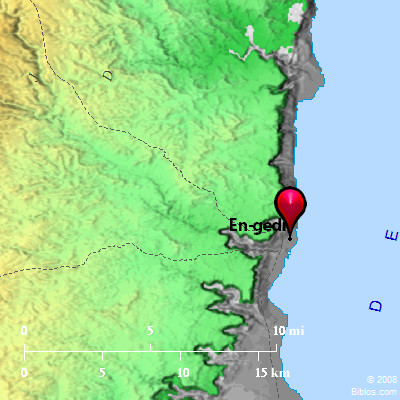Atlas  Jeshimon (En-gedi) and surrounding area
Maps Created using Biblemapper 3.0Additional data from OpenBible.info
You are free to use up to 50 Biblos coprighted maps (small or large) for your website or presentation. Please credit Biblos.com. Occurrences 1 Samuel 23:19 Then the Ziphites came up to Saul to Gibeah, saying, "Doesn't David hide himself with us in the strongholds in the wood, in the hill of Hachilah, which is on the south of the desert? 1 Samuel 23:24 They arose, and went to Ziph before Saul: but David and his men were in the wilderness of Maon, in the Arabah on the south of the desert. 1 Samuel 26:1 The Ziphites came to Saul to Gibeah, saying, "Doesn't David hide himself in the hill of Hachilah, which is before the desert?" 1 Samuel 26:3 Saul encamped in the hill of Hachilah, which is before the desert, by the way. But David stayed in the wilderness, and he saw that Saul came after him into the wilderness. Encyclopedia JESHIMONje-she'-mon, jesh'-i-mon (ha-yeshimon, "the desert," and in the Revised Version (British and American) so translated but in the King James Version, Numbers 21:20; Numbers 23:28 1 Samuel 23:19, 24; 1 Samuel 26:1, 3, "Jeshimon" as a place-name. In Numbers, the Septuagint reads he eremos, "the desert"; in 1 Samuel, the Septuagint reads Iessaimon): In these passages probably two districts are referred to:
(1) The "desert" North of the Dead Sea, which was overlooked from Pisgah (Numbers 21:20; Numbers 23:28). This is the bare and sterile land, saturated with salt, lying on each side of the Jordan North of the Dead Sea, where for miles practically no vegetable life can exist.
(2) The sterile plateau West of the steep cliffs bordering the western shores of the Dead Sea. Here between the lower slopes of the Judean hills, where thousands of Bedouin live and herd their flocks, and the more fertile borders of the sea with their oases (`Ain Feshkhah, `Ain Jidy, etc.), is a broad strip of utterly waterless land, the soft chalky hills of which are, for all but a few short weeks, destitute of practically any vegetation. The Hill of Hachilah was on the edge of this desert (1 Samuel 23:19; 1 Samuel 26:1, 3), and the Arabah was to its south (1 Samuel 23:24). It is possible that the references in Numbers may also apply to this region.
The word "Jeshimon" (yeshimon) is often used as a common noun in referring to the desert of Sinai (Deuteronomy 32:10 Psalm 78:40; Psalm 106:14 Isaiah 43:19, etc.), and except in the first two of these references, when we have "wilderness," it is always translated "desert." Although used in 7 passages in poetical parallelism to midhbar, translated "wilderness," it really means a much more hopeless place; in a midhbar animals can be pastured, but a yeshimon is a desolate waste.
E. W. G. Masterman |
    |




